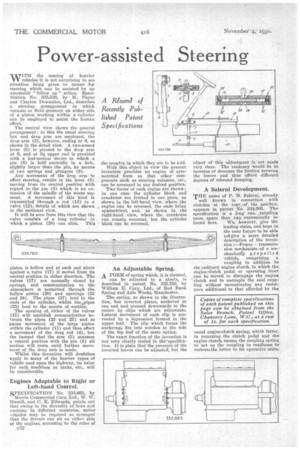Power-assisted Steering
Page 82

If you've noticed an error in this article please click here to report it so we can fix it.
A RISum1 of Recently Published Patent Specifications
WITH the coming of heavier vehicles it is not surprising to see attention being given to means for steering which can be assisted by an automatic 'follow up" action. Specification No. 335,539, by M. Payne and Clayton Dewandre, Ltd., describes a steering arrangement in which vacuum or fluid pressure on either side of a piston working within a cylinder can be employed to assist the human effort.
The central view shows the general arrangement ; in this the usual steering box and drop arm are employed, the drop arm (3), however, ending at 6, as shown in the detail view. A two-armed lever (5) is pivoted to the drop arm at 6, and at its upper end is provided with a lost-motion device in which a pin (8) is held centrally in a hole, slightly larger than the pin, by means of two springs and plungers (9)• Any movement of the drop arm to effect steering, results in the lever (5) moving from its central position with regard to the pin (8) which is an extension of the spindle of the worm segment. A movement of this kind is transmitted through a rod (13) to a valve (12), details of which are shown in .the sectional view.
It will be seen from this view that the valve consists of a long cylinder in which a piston (20) can slide. This piston is hollow and at each end abuts against a valve (17) if moved from its central position in either direction. The valves (17) are normally closed by springs, and communication to the atmosphere is permitted through the hollow piston (20) and openings (23 and 24). The pipes (27) lead to the ends of the cylinder, whilst the,pipes (25) lead to the source of suction.
The opening of, either of the valves (17) will establish communication between the pipes (25 and 27) and so cause movement of the large piston within the cylinder (11) and thus effect a movement of the drag rod (4), but the instant that the arm (5) assumes a central position with the pin (8) all motion will cease until further movement of the drop arm is made.
Whilst this invention will doubtless apply to many of the heavier types of vehicle used upon the highway, its value for such machines as tanks, etc., will be considerable.
Engines Adaptable to Right or Left-hand Control.
SPECIFICATION No. 335,663, by Morris Commercial Cars, Ltd., W. W. Hamill, and C. K. Edwards, points out that owing to the diversity of laws and customs in different countries, motor vehicles may be required so arranged that the drivers can sit on either side of the engines, according to the rules of the country in which they are to be sold.
With this object in view the present invention provides an engine of symmetrical form so that other components such as steering columns, etc.. can be arranged in any desired position.
Two forms of such engine are shown ; in one case the cylinder block and crankcase are formed in one piece, as shown in the left-hand view, where the engine can be reversed, the ends being symmetrical, and, as shown in the right-hand view, where •the crankcase can remain constant, but the cylinder block can be reversed.
An Adjustable Spring. A FORM of spring which, it is claimed,
can be adjusted to a nicety, is described in patent No. 335,750, by William E. Cary, Ltd., of Red Bank Spring and Axle Works, Manchester.
The spring, as shown in the illustration, has inverted plates, anchored at one end and pressed downwards in the centre by clips which are adjustable. Lateral movement of each clip is prevented by a depression formed in the upper leaf.' The clip which forms the anchorage fits into notches in the side of the top leaf of the main spring.
The exact function of the invention is not very clearly stated in the-specification. It is plain that the pressure of the inverted leaves can be adjusted, but the
object of this adjustment is not made very clear. The tendency would be to increase or decrease the friction between the leaves and thus afford different degrees of rebound damping.
A Salerni Development.
THE name of P. M. Salerni, already,
well known in connection with clutches at the rearof the gearbox, appears in patent No. 334,503. The specification is a long one, entailing more space than can conveniently be found here. We, however, give the leading claim, and hope in the near future to be able tot give a more detailed description of the invention :—Power transmission mechanism-of a mechanically propelle d vehicle, comprising a coupling in addition to the ordinary engine clutch, in which the engine-clutch pedal or operating lever can be moved to disengage the engine clutch and to uncouple the said coupling without encountering any resistance additional to that afforded by the usual engine-clutch spring, which latter, in returning the clutch pedal and the engine clutch, causes the coupling spring to act on the coupling in readiness to restore3the latter to its operative state.




























































































































